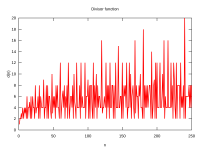Divisor function

Imagine you have a bunch of candies and you want to share them with your friends. But instead of just giving everyone the same number of candies, you want to share them in a special way. The divisor function helps you figure out how many ways you can divide the candies among your friends.
The divisor function is like a magical button that tells you how many divisors a number has. Divisors are the numbers that can divide another number exactly without leaving any leftovers. For example, if you have 12 candies, the divisors are 1, 2, 3, 4, 6, and 12 because these numbers can divide 12 without any leftover candies.
Now, let's say you have 12 candies and you want to share them with your friends. You can give all the candies to one friend, which is one way to divide them. Or you can give 2 candies to 6 friends, which is another way. You can also give 3 candies to 4 friends, or 4 candies to 3 friends, or 6 candies to 2 friends, or even 12 candies to 1 friend. So, in total, you can divide your 12 candies in 6 different ways.
The divisor function is like a special machine that spits out the answer without you having to check all the possible divisions. You just need to put in the number of candies you have, like 12, and then press the button. The machine will tell you that the number 12 has 6 divisors.
The divisor function is actually very useful in math because it helps us understand the properties of numbers. For example, we can use the divisor function to find out if a number is prime or composite. If a number has only two divisors, 1 and itself, then it is a prime number. But if a number has more than two divisors, then it is composite. In the case of 12, since it has 6 divisors, it is a composite number.
So, next time you have a bunch of candies and want to share them with your friends, remember the divisor function can help you figure out how many ways you can divide them. And who knows, maybe you'll discover some interesting properties of numbers along the way!
The divisor function is like a magical button that tells you how many divisors a number has. Divisors are the numbers that can divide another number exactly without leaving any leftovers. For example, if you have 12 candies, the divisors are 1, 2, 3, 4, 6, and 12 because these numbers can divide 12 without any leftover candies.
Now, let's say you have 12 candies and you want to share them with your friends. You can give all the candies to one friend, which is one way to divide them. Or you can give 2 candies to 6 friends, which is another way. You can also give 3 candies to 4 friends, or 4 candies to 3 friends, or 6 candies to 2 friends, or even 12 candies to 1 friend. So, in total, you can divide your 12 candies in 6 different ways.
The divisor function is like a special machine that spits out the answer without you having to check all the possible divisions. You just need to put in the number of candies you have, like 12, and then press the button. The machine will tell you that the number 12 has 6 divisors.
The divisor function is actually very useful in math because it helps us understand the properties of numbers. For example, we can use the divisor function to find out if a number is prime or composite. If a number has only two divisors, 1 and itself, then it is a prime number. But if a number has more than two divisors, then it is composite. In the case of 12, since it has 6 divisors, it is a composite number.
So, next time you have a bunch of candies and want to share them with your friends, remember the divisor function can help you figure out how many ways you can divide them. And who knows, maybe you'll discover some interesting properties of numbers along the way!
Related topics others have asked about:
